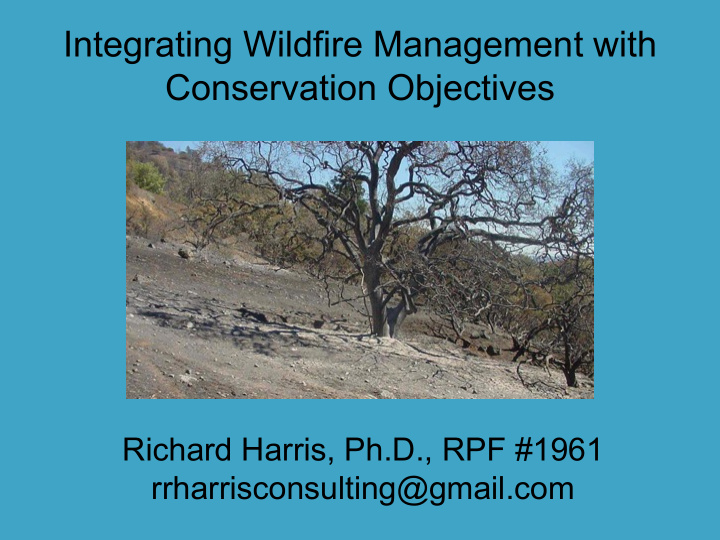



Integrating Wildfire Management with Conservation Objectives Richard Harris, Ph.D., RPF #1961 rrharrisconsulting@gmail.com
Projects
Objectives and Application • Provide compendium of practices to balance fuel reduction and habitat/species conservation. • Ensure consistency with HCP/NCCP avoidance and minimization measures. • Initially apply to HCP/NCCP conservation reserves. • May apply to other activities covered under the HCP/NCCP. – Vegetation management in subdivisions – Community wildfire protection projects – Parks and open space outside reserve system • Encourage adoption by entities conducting fuel treatments e.g., Firesafe Councils, RCDs, etc. Incorporate into Community Wildfire Protection Plans.
Protected Habitats and Species: Santa Clara Valley • Most species are associated with serpentine grasslands, wetlands and ponds. • Plan proposes acquisition of 4000 acres of serpentine grassland, 12,900 acres of oak woodland and 13,300 acres of annual grassland.
Habitats and Species: Santa Clara Valley (cont.)
Protected Habitats and Species: Placer County • Six habitats and 14 covered species are included in the proposed Plan. • A reserve system including 17,000 acres of vernal pool grassland, 10,000 acres of oak woodland and 8,000 acres of agricultural and other natural communities is proposed.
Protected Habitats and Species: Placer County (cont.)
Assessing Existing Fire Hazard: Landscape Scale
Assessing Site-Specific Hazards: Fuel Loads, Topography, Probability of Ignition, Access to Fire Fighters
Exposure of Human Assets: Proximity to Development, Access
Goals of Treatments • Provide defensible space within reserves and extending onto adjacent properties if necessary. • Prevent fire from spreading from one habitat type to another or from a reserve to neighboring properties. • Reduce fuels in habitats with excessive accumulations or to achieve restoration objectives. • Avoid adverse impacts on covered species or other environmental conditions.
Defensible Space Before After Goals are to reduce probability of structure ignition and create a safe area for fire-fighters to work. Defensible space may extend from a conservation reserve onto adjacent property.
Shaded Fuel Breaks
Fuel Breaks Goals are to interrupt fire spread, change fire behavior (crown to ground fire) and provide a staging area to fight the fire.
Fuel Break Positioning • Along ridge lines. • Along roads. • At land use boundaries e.g., interface of conservation reserves and urbanized areas. • Width normally varies from 100-200 feet.
Guidelines for Shaded Fuel Breaks • Retain larger trees (normally understory trees removed up to a specified diameter limit while retaining ones that are not ladder fuels). • Prune trees to a height of 8-10 feet above the ground. • Separate crowns of residual trees. • Remove or treat in place slash and small dead and down material. • Retain trees with obvious wildlife use and snags greater than 18 inches DBH that are not adjacent to a road or structure. • Retain some shrub cover, particularly species that provide wildlife food or cover. • Shrub cover should be left in patches that are separated from trees (not within their drip lines).
Treatment Methods
Conditions on Treatments Avoidance and minimization measures are applied at the habitat level and species level for covered wildlife and plants. Example: Placer County Conservation Plan.
Avoidance and Minimization Example: Santa Clara Valley
Treatment Planning • Management plans for conservation reserves will include a wildfire management component. • Priorities for treatment will be based on risk to resources and human assets, costs and funding availability. • There is a great opportunity to coordinate Habitat Agency planning with community wildfire protection.
Best Management Practices • To ensure that treatments have no significant impacts the Guidelines include BMPs applicable to: – Stream protection – Wetland protection – Topographic and geologic constraints – Cultural resources – Wildlife (general) – Exotic species • These are in addition to the minimization and avoidance conditions. • Fuel treatments are commonly subject to CEQA.
Grazing and Prescribed Fire • The majority of treatments will be either grazing or prescribed burning in grasslands, serpentine grasslands and other habitats. • Partner agencies and enrollees have substantial experience with both methods. • We are recommending that work groups be created to develop appropriate prescriptions.
Wildfire Suppression: What Happens When a Fire Occurs Within a Reserve? • The Guidelines recommend that “minimum impact suppression tactics” be applied to fires that occur within conservation reserves to avoid and/or minimize resource damages. • Implementation of MIST requires coordination between suppression forces and reserve managers. • Some agencies have achieved this coordination with past incidents. • At the very least, conservation agency resource managers should be included in incident response teams to address avoidance and post-fire remediation.
Some Next Steps • Guidelines for grazing in conservation reserves should be developed. • Projects proposed by others in covered habitats should adhere to the Guidelines. • Consideration might be given to fee offsets for folks doing treatments according to the Guidelines. • The Guidelines should be incorporated into Community Wildfire Protection Plans (already the case in Santa Clara).
Questions and Discussion
Check out the webinar recordings and resources at the following website: https://tinyurl.com/y7ttn3t3
Recommend
More recommend